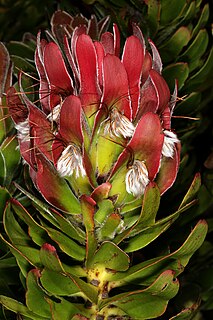Related Research Articles

Earias clorana, the cream-bordered green pea, is a moth of the family Nolidae. It is found in most of Europe eastwards across the Palearctic to the Urals and Western Siberia.

Pseudoips prasinana, the green silver-lines is a moth of the family Nolidae, common in wooded regions, and having a wingspan of 30–35 mm. It is found in the Palearctic realm.

Mimetes fimbriifolius, also called cowl pagoda or the fringed pagoda, is a species of plant in the family Proteaceae. It is a dense, rounded, multi-branched tree that grows up to 4 metres in height. This attractive and striking plant flowers all year round, and produces red and yellow branch-heads and inflorescences. The nectar-rich flowers are pollinated by sunbirds and the seeds are distributed and taken underground by ants before germinating. It is endemic to the Table Mountain range in the city of Cape Town, South Africa.
Ypsolopha undulatella is a moth of the family Ypsolophidae. It is known from the United States, including Arizona, Utah and Colorado.

Thisizima subceratella is a moth of the family Tineidae. It is found in China.
Styphlolepis leucosticta is a moth in the family Crambidae. It was described by George Hampson in 1919. It is found in Australia, where it has been recorded from Western Australia.
Blepharomastix fusalis is a moth in the family Crambidae. It was described by George Hampson in 1917. It is found in Colombia.
Syngamia albiceps is a moth in the family Crambidae. It was described by George Hampson in 1912. It is found in Singapore.
Dichomeris adactella is a moth in the family Gelechiidae. It was described by Francis Walker in 1864. It is found in Australia.
Commatica extremella is a moth in the family Gelechiidae. It was described by Francis Walker in 1864. It is found in Amazonas, Brazil.
Compsolechia binotatella is a moth of the family Gelechiidae. It was described by Francis Walker in 1864. It is found in Amazonas, Brazil.
Stenoma acontiella is a moth of the family Depressariidae. It is found in Amazonas, Brazil.
Stenoma chalybaeella is a moth of the family Depressariidae. It is found in Amazonas, Brazil.
Timyra phycisella is a moth in the family Lecithoceridae. It was described by Francis Walker in 1864. It is found in Sri Lanka.
Tisis chalybaeella is a moth in the family Lecithoceridae. It was described by Francis Walker in 1864. It is found on Borneo.
Lecithocera adelella is a moth in the family Lecithoceridae. It was described by Francis Walker in 1864. It is found on Borneo.
Lecithocera leucotella is a moth in the family Lecithoceridae. It was described by Francis Walker in 1864. It is found on Borneo.
Allotropha is a monotypic moth genus in the family Depressariidae described by Alexey Diakonoff in 1954. Its only species, Allotropha percussana, was described by Francis Walker in 1864. It is found in Australia, where it has been recorded from Tasmania.
Cryptolechia hecate is a moth in the family Depressariidae. It was described by Arthur Gardiner Butler in 1883. It is found in Chile.
Gonioterma burmanniana is a moth in the family Depressariidae. It was described by Caspar Stoll in 1782. It is found in Brazil.
References
- ↑ Menesta at Markku Savela's Lepidoptera and Some Other Life Forms.
- ↑ List of the Specimens of Lepidopterous Insects in the Collection of the British Museum 29: 626
| This article on a moth of the family Depressariidae is a stub. You can help Wikipedia by expanding it. |